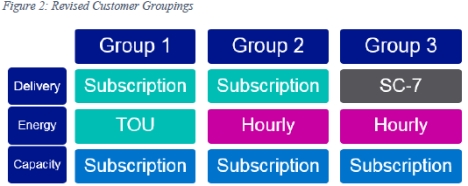|
|
|
|
|
Update: New York Utility Revises Cost Recovery Mechanism Under Proposed "Subscription" Electricity Supply Option For Non-shopping Customers
The following story is brought free of charge to readers by EC Infosystems, the exclusive EDI provider of EnergyChoiceMatters.com
Niagara Mohawk (National Grid or "the Company") has filed at the New York PSC further revisions to its Clifton Park Demand Reduction REV Demonstration Project, with changes to a proposal to use a subscription model for part of the electric supply charges applicable to a subset of non-shopping customers who receive electric supply from the utility
Specifically, NiMo now proposes that all groups in the project who receive supply from NiMo shall pay for capacity on a subscription basis. As originally proposed, a single group (Group 1) would have paid for capacity on a subscription basis, with the other groups (Groups 2 and 3) paying for capacity via monthly charges based on their ICAP tag, with the customer’s ICAP obligation set based on their usage during the New York Control Area (NYCA) peak hour in the previous year, and the monthly charges for capacity varying based on the monthly capacity prices at the NYISO.
See our prior story here for more details on the various supply pricing proposals for the various groups in NiMo's original proposal
Under the proposed revisions, NiMo now proposes to recover capacity costs for all customers in the demonstration through the subscription method. "By standardizing the treatment of capacity costs, the Company can better focus the results," NiMo said
The results in a change for Group 2 and Group 3 customers (Group 1 originally had a subscription model for capacity)
Under the revisions, all groups would be charged for capacity based on the customer’s Subscription kW. NiMo noted that capacity costs could be based on a comparable subscription rate or, alternatively, the Company could standardize
the capacity treatment for all customers by recovering capacity costs from customers in each group based on their
actual ICAP charges. Such a method would more accurately reflect how those costs are incurred NiMo said
As a result of the change, customers in Groups 1 and Group 2 would be identical except for the treatment of energy costs:
Group 1 has a time-of-use period; while Group 2 would see the day-ahead hourly price.
The
difference between Groups 2 and Group 3 would be in their delivery service. Group 2 would use relatively static subscription rate that would be the same across all months, while Group 3 would
use the mass market Standby rates (SC-7) following Commission approval of that rate.
There is no change in how energy supply costs would be recovered from various groups, which would be either time of use or hourly, depending on group, as more fully discussed in our prior story (details here)
A summary of how the Groups would be charged under the revised project proposal is below:
"Applying a standard treatment of capacity charges across the three groups would enable the
Company to better isolate and evaluate the effects of differing delivery and energy rates on
customer behavior," NiMo said
In NiMo's original proposal, the subscription capacity charge was described as follows (at the time, for Group 1):
Subscription Capacity Charge – The Subscription Capacity Charge will be determined as the product of the customer’s Subscription Demand and the Subscription Capacity Rate ($/kW) in effect during the billing period.
A Subscription Demand (kW) will be established for each customer on an annual basis and will be determined as the average of the customer’s five highest measured kW demands that occur on separate weekdays, excluding holidays, during the hours of 2pm to 7pm during the period from June 24 through September 15 of the previous calendar year, rounded to the nearest whole number.
The Subscription Capacity Rate ($/kW) will be determined as the product of: (i) the twelve month forecasted capacity price ($/kW-mo) based on available market prices, (ii) the sum of one plus the forecasted annual Unforced Capacity Requirement of the NYISO, (iii) the sum of one plus the forecasted annual Demand Curve Requirement of the NYISO, and (iv) the sum of one plus the Average Unaccounted For Energy Factor as specified in Rule 39, plus any applicable taxes.
Case 19-E-0111
ADVERTISEMENT Copyright 2010-20 Energy Choice Matters. If you wish to share this story, please
email or post the website link; unauthorized copying, retransmission, or republication
prohibited.
January 28, 2020
Email This Story
Copyright 2010-20 EnergyChoiceMatters.com
Reporting by Paul Ring • ring@energychoicematters.com

NEW Jobs on RetailEnergyJobs.com:
• NEW! -- Senior Consultant - Competitive Energy Markets -- Houston
• NEW! -- Channel Relations Manger -- Retail Supplier
• NEW! -- Customer Service Representative -- Retail Supplier
• NEW! -- Renewables and Energy Trader -- Retail Supplier
|
|
|
|










